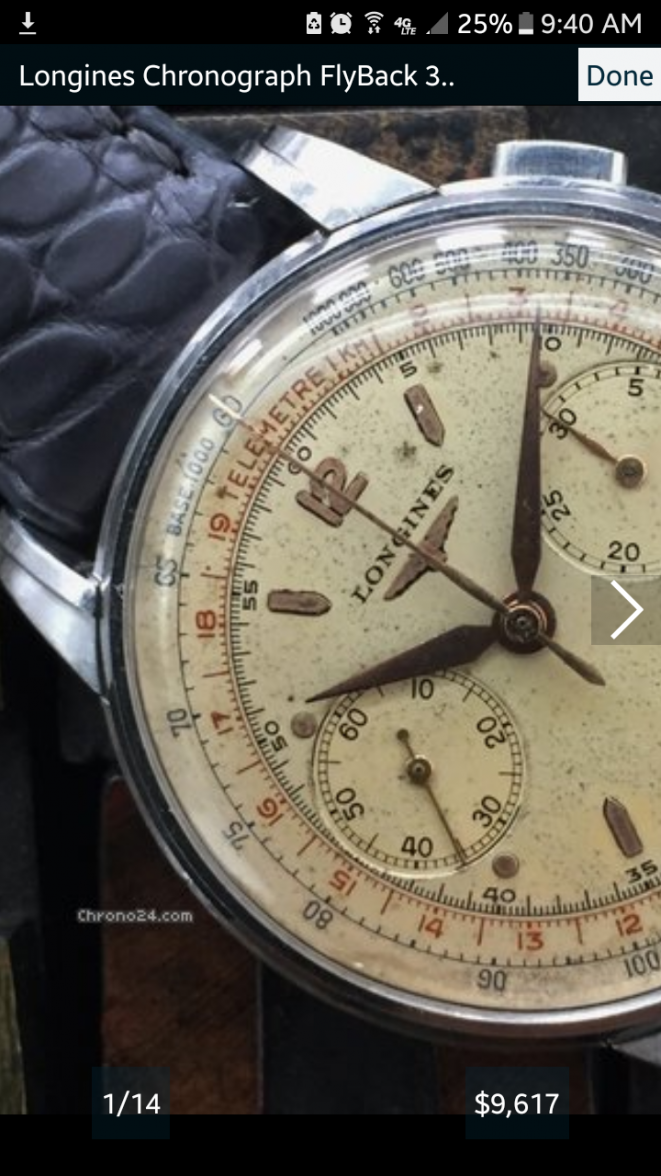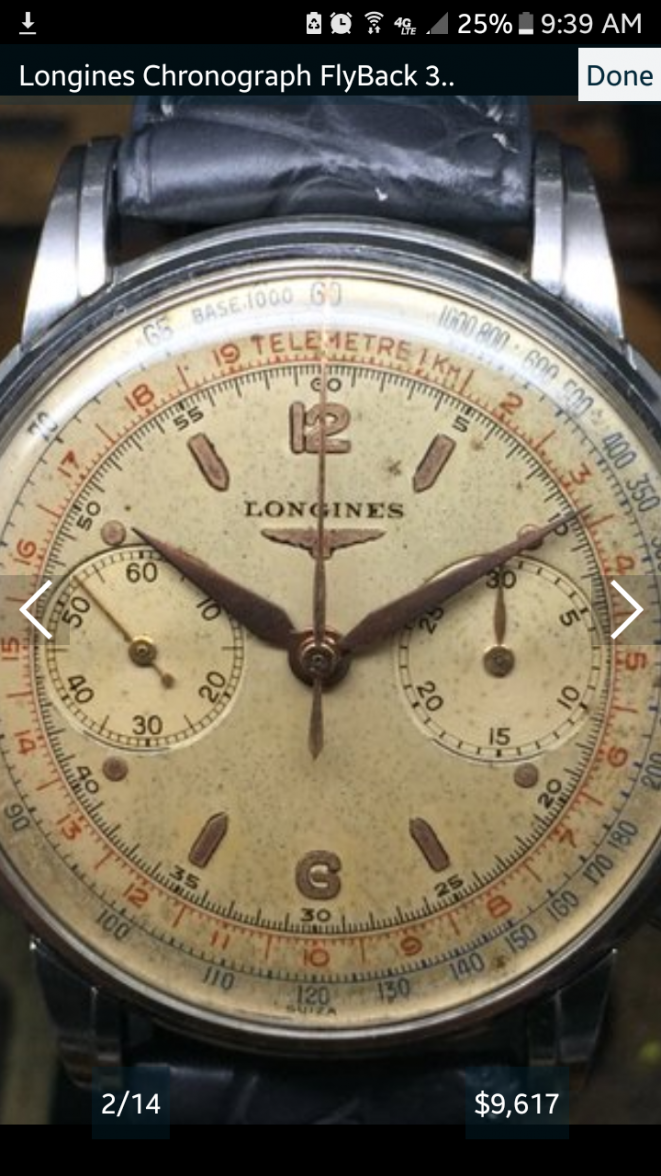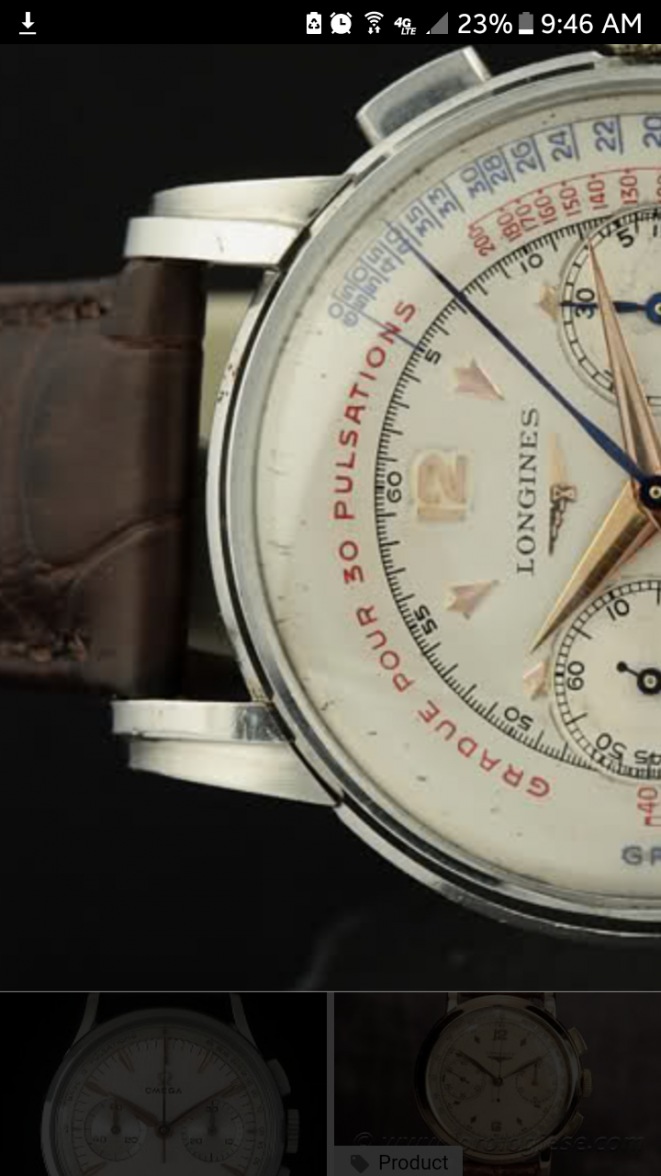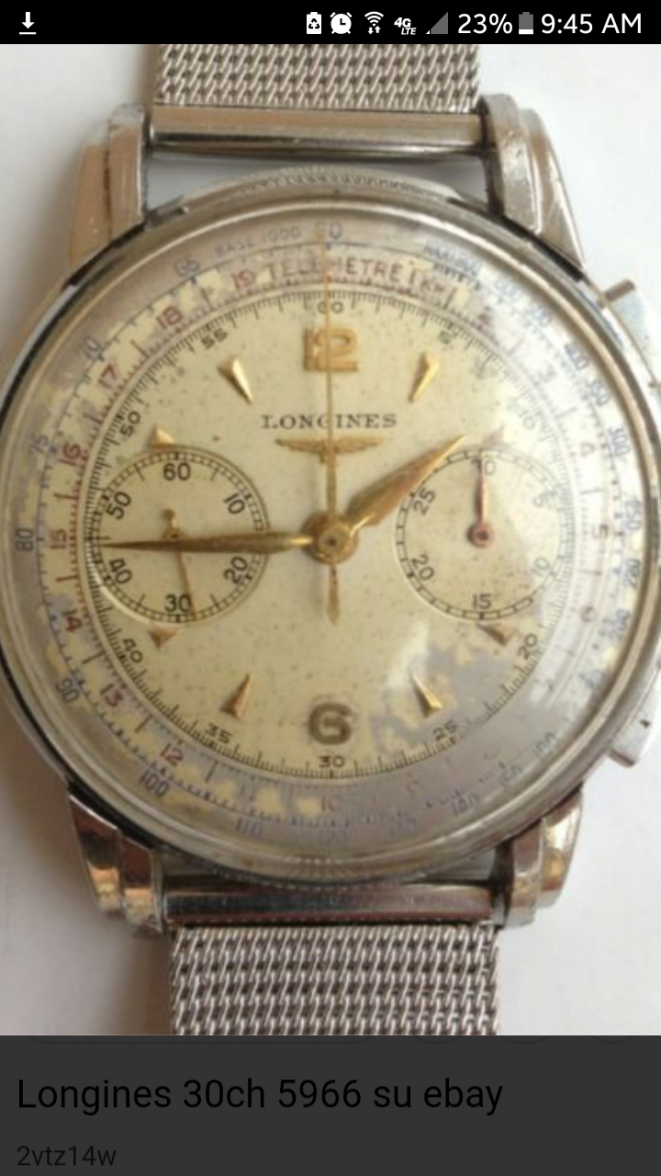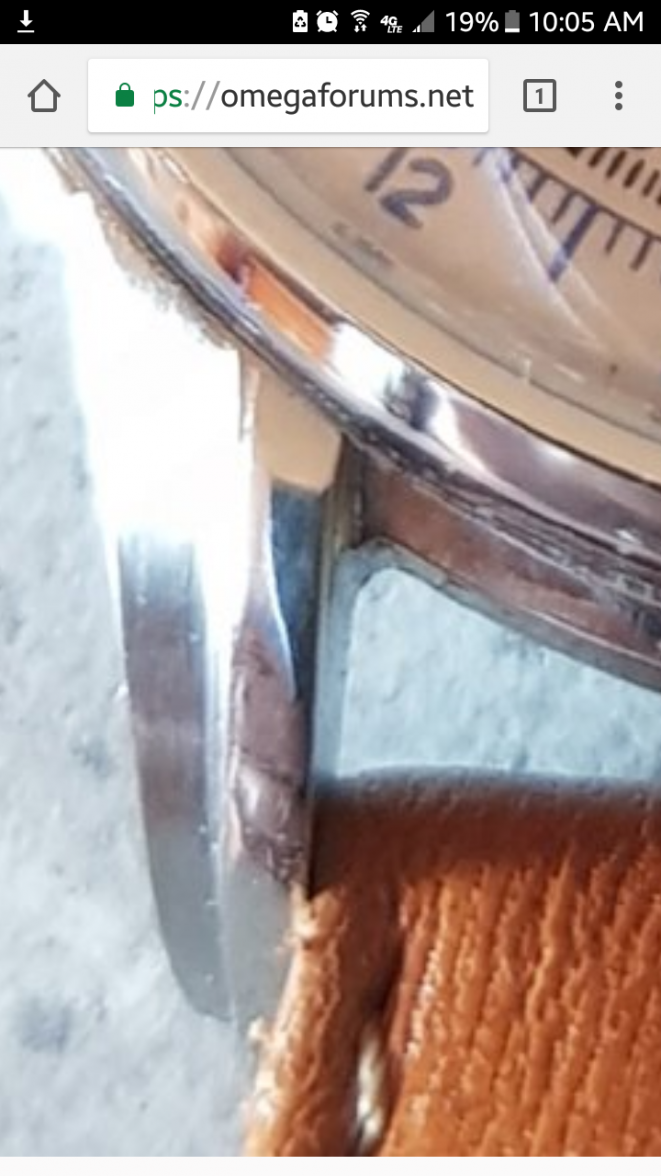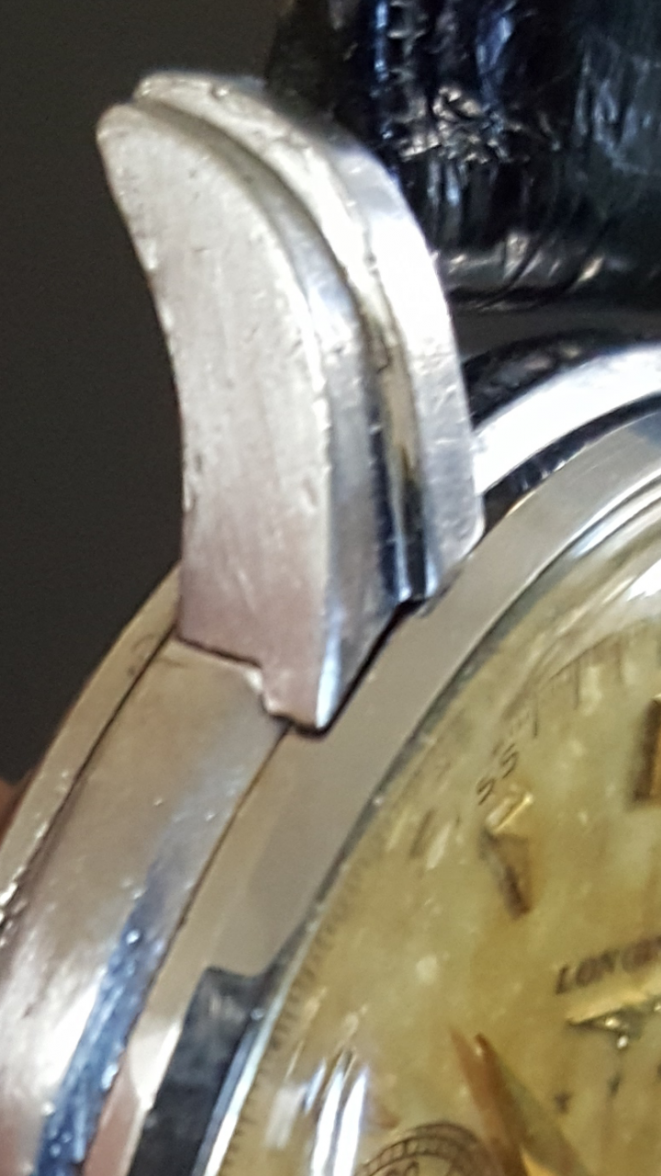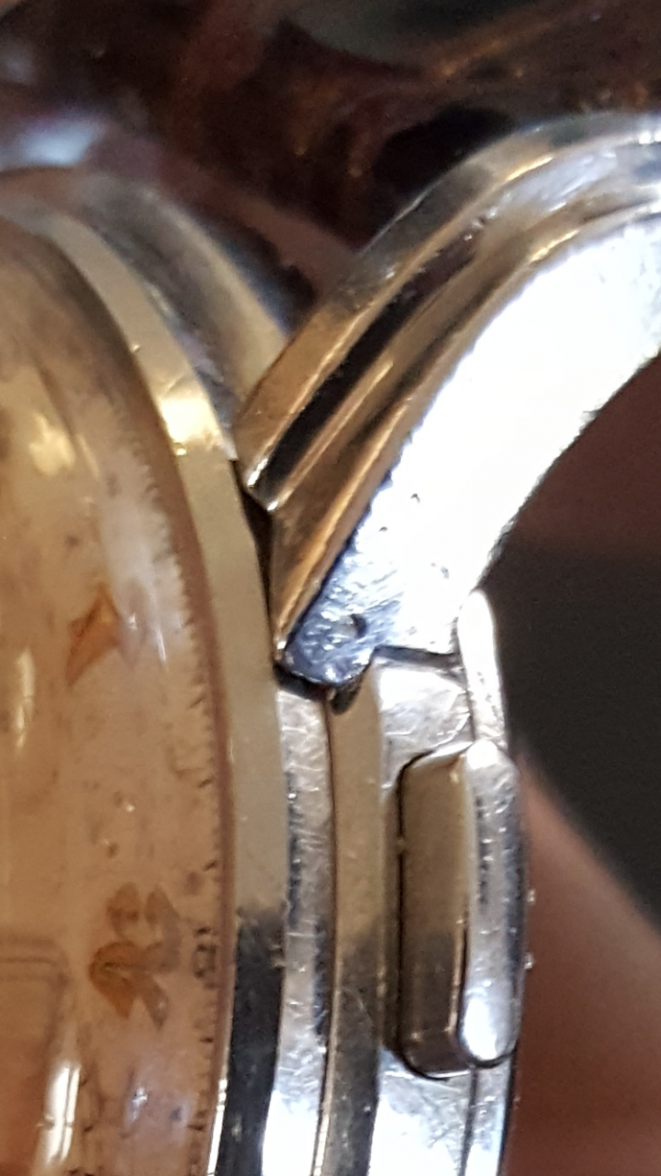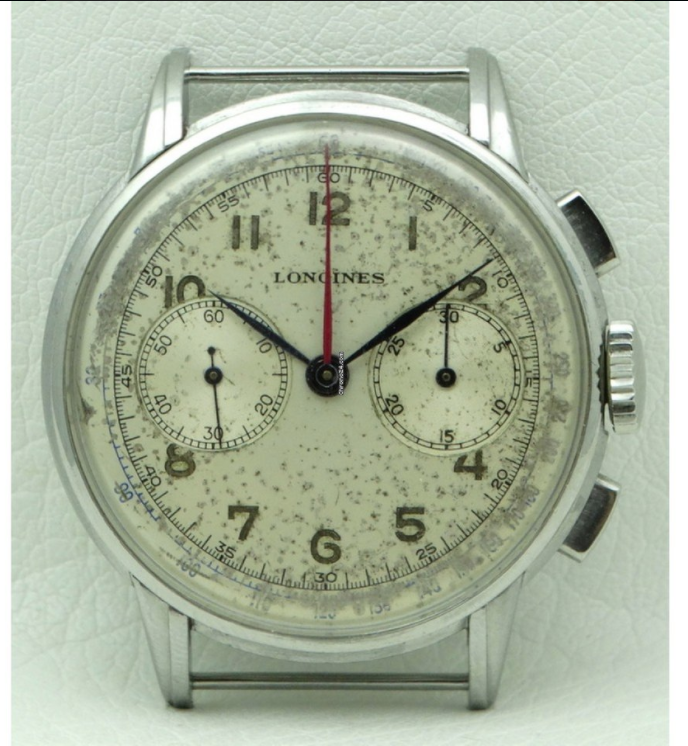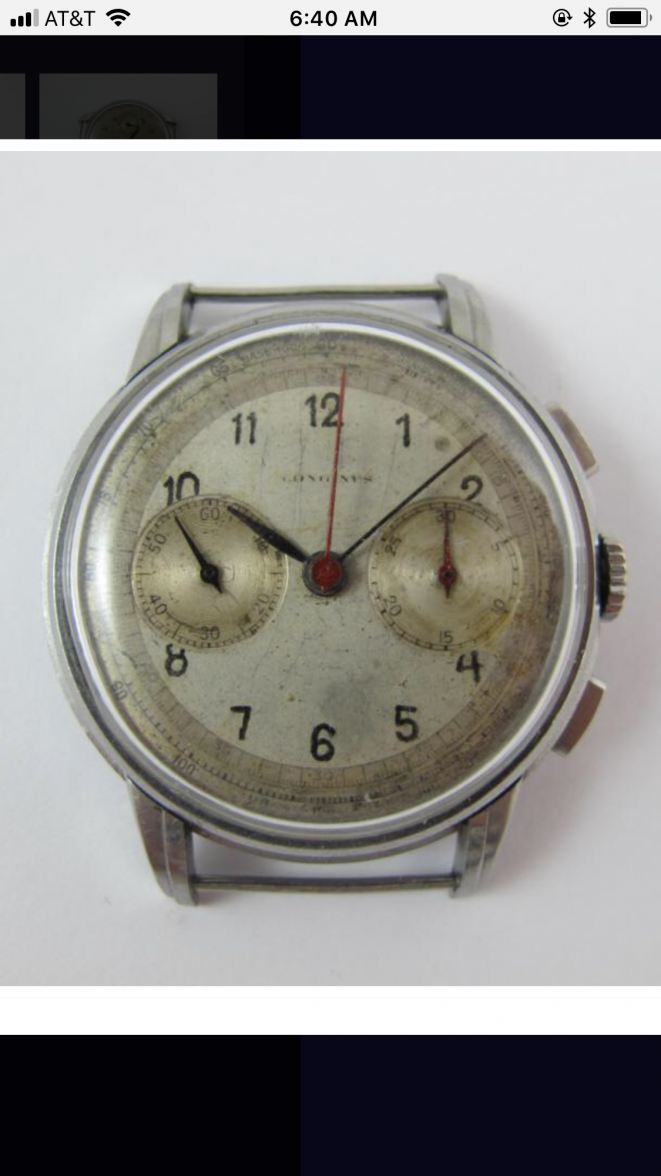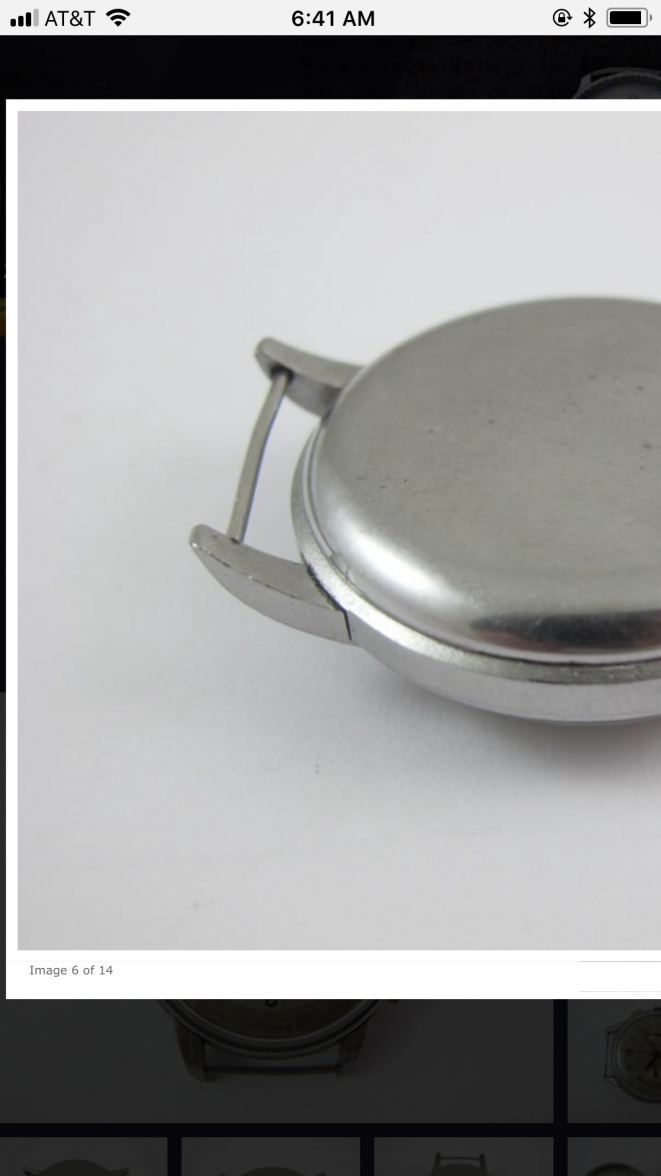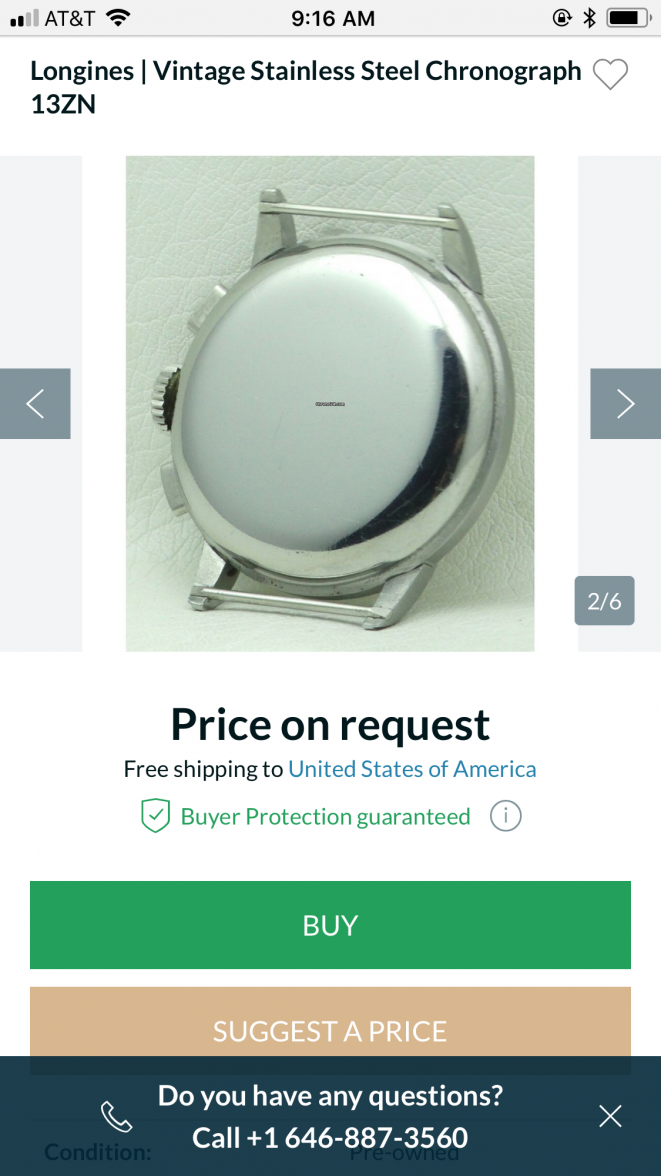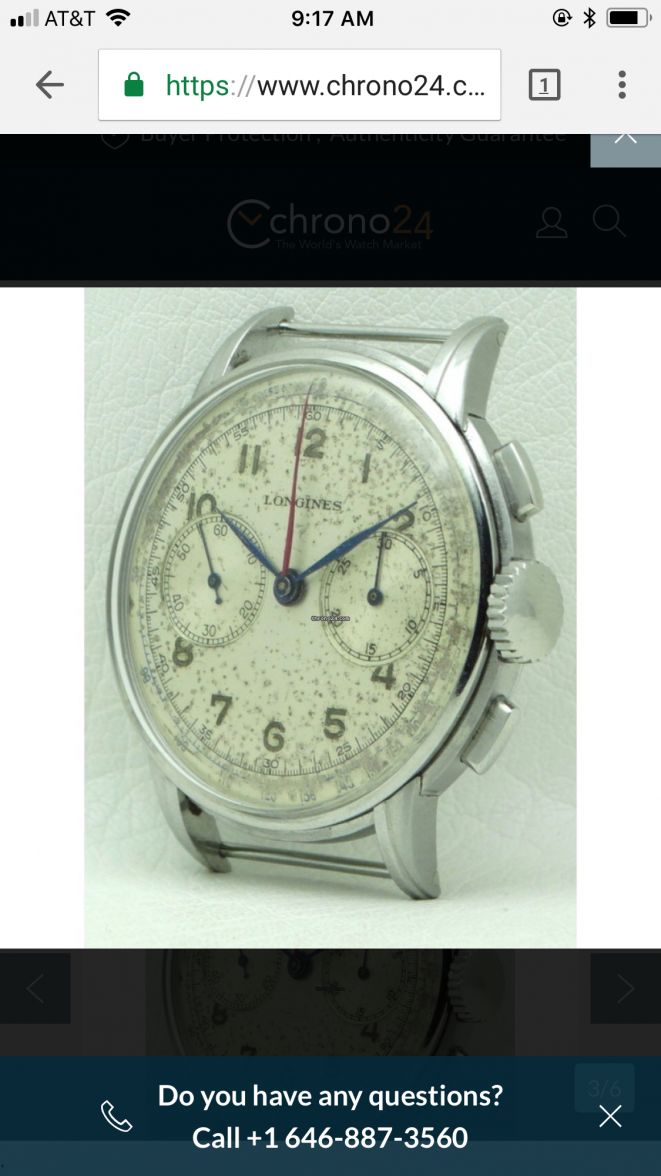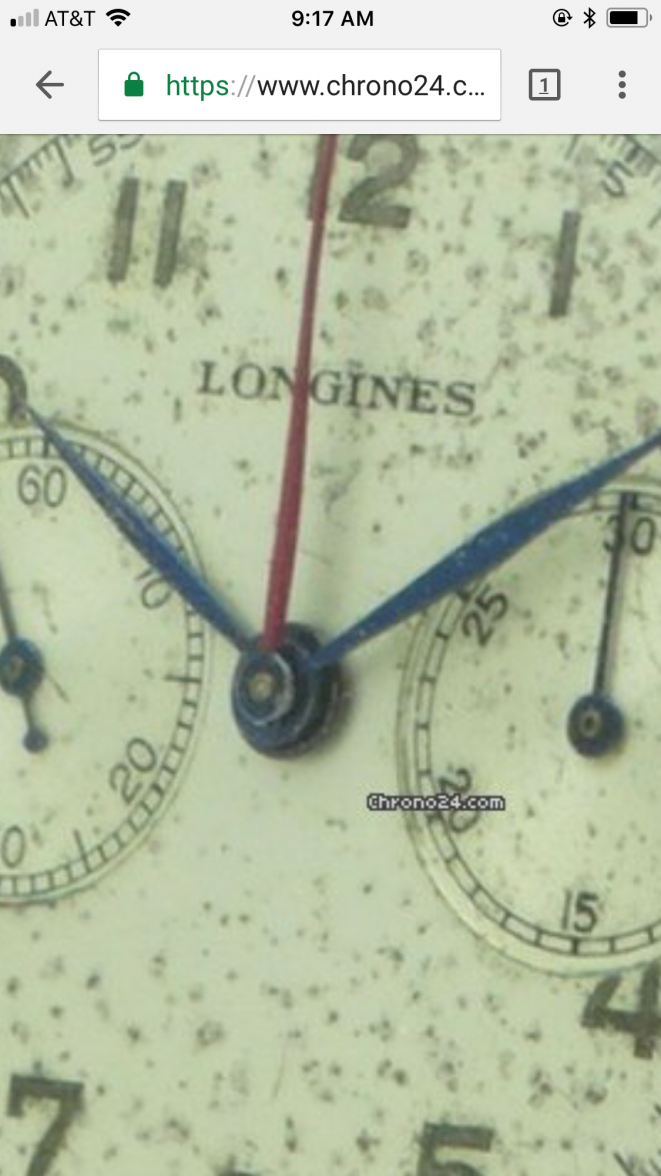13ZN Chronographs Inquiries and Information.
Lépine
·Gabe
·How about this watch, same case style, with fixed lugs 13zn movement...
https://www.chrono24.com/longines/-vintage-stainless-steel-chronograph-13zn--id6448811.htm
https://www.chrono24.com/longines/-vintage-stainless-steel-chronograph-13zn--id6448811.htm
Lépine
·I don’t think fixed bars are correct. Hands are not normally these. I have seen one more just like this one. But, to be clear, no one will buy it. It has been up for sale for more than a year.
This one good.
https://www.chrono24.com/longines/chronograph-flyback-30ch--id5254951.htm
This one good.
https://www.chrono24.com/longines/chronograph-flyback-30ch--id5254951.htm
Edited:
minutenrohr
·My assessment: nobody can judge a 13ZN by using only one lowres pic. So, what I can see is a correct winding crown, correct hands (but not the red one), a probably correct dial (one had to look on a highres pic, the dial foot near the balance, the counters etc, etc...) and a case type which could belong to a late 13ZN as well as an early 30CH. To get more certainty, you must have a look on the inner caseback.Furthermore you have to decide, if the case style and numbers/symbols shown on the inner caseback are matching with the movement number. An early movement (f.i. 5,4 - 6 mio.) should be not together with a late case reference like f.i. 23485 or 23020, a "LXW" marked balance cock is not a good match with a "fab. suisse" dial. And some more small things like that.
So - pardon me - it is not useful to discuss and judge pics like the one above. Except the questioner will accept a big and meaningful MAYBE...
rgds - h.u.
So - pardon me - it is not useful to discuss and judge pics like the one above. Except the questioner will accept a big and meaningful MAYBE...
rgds - h.u.
Lépine
·Here is the other one I know of. Suggests there were many created this way. I have to verify but seems USSR source. Issued Military? I have only seen two. They are different enough that there should be many to explain an evolution. But, we can find only two...and they come from Eastern Block...and they don’t match if the were a small special order batch...like military order.
Edited:
minutenrohr
·...same old story, same old song. What could we state about such a watch? Dubious case, overpainted (maybe partly original) dial. A wild bunch of hands. Inner caseback view? Movement? But after all: an apparently original but worn crown. IMHO a real waiste of time...
P.S.: Why should it be a military watch? The fact that actually every tenth watch on ebay has been declared as "military" is not a good reason to presume that this eastern (?) beauty could have been sold to armed forces.
P.S.: Why should it be a military watch? The fact that actually every tenth watch on ebay has been declared as "military" is not a good reason to presume that this eastern (?) beauty could have been sold to armed forces.
Lépine
·You have me misunderstood. I would not go near it. I suggest no one will buy them. I say stay away unless you know for sure what it is. The one I posted is in Eastern Europe. Only two show up...no good explanation. Not military like. Inconsistent is what I say.
minutenrohr
·Hi Seiji,
that´s it: "I say stay away unless you know for sure what it is" !!!
rgds - h.u.
that´s it: "I say stay away unless you know for sure what it is" !!!
rgds - h.u.
Lépine
·So, I suggest looking at the Longines 30ch ref 5966 on Chrono24 which is just as sought after as many 13zn. It is rare steel model and looks perfect in my opinion. And in long run is much easier to verify and will be easier for other collectors to buy and sell. So I said, better to stay away from the "Eastern Block" 13zn "5966" style watch. I have not found anyone who knows what they really are.
Lépine
·minutenrohr
·Well, a further opportunity is to buy a golden one from a trusted OF-member. No risk - much fun. Gold cased 5966s are not too fashionable yet, but relatively cheap and (as well as 13ZNs) available as "non-hourglass" dial-variants.
https://omegaforums.net/threads/sold-vintage-longines-30ch-chronograph---37mm-and-18k-gold.57648/
Then you just have to wait some time for the upcoming Phillips auction "Golden Milestones: 38 legendary gold-watches that shaped history".
After that you will be able to sell the watch for a good price and move to a noble suburb area.
https://omegaforums.net/threads/sold-vintage-longines-30ch-chronograph---37mm-and-18k-gold.57648/
Then you just have to wait some time for the upcoming Phillips auction "Golden Milestones: 38 legendary gold-watches that shaped history".
After that you will be able to sell the watch for a good price and move to a noble suburb area.
minutenrohr
·..forgot: usually the gold cased examples has been produced in a lower number than the steel cased ones. Maybe 1:10 ?
Lépine
·Longines gave you the production numbers?
minutenrohr
·no, but regarding the price differences between gold- and steel cased watches in the forties or fifties, my guess shouldn´t be completely wrong.
Lépine
·I don’t know either. Museum has declined on a couple of refs I asked about. I think too much data to manually count in archive books.
I think depends on ref.
A google search of 30CH photos usually produces more Yellow Gold 18k by far. Next is steel. Next pink gold.
13zn: Most to least; Yellow 18K, Yellow 14K, Steel, Pink 18K. Finally, red gold pretty rare.
Italian forums like OP say similar.
Longines chronos always historically priced like Rolex Daytonas. Never were cheap.
I think depends on ref.
A google search of 30CH photos usually produces more Yellow Gold 18k by far. Next is steel. Next pink gold.
13zn: Most to least; Yellow 18K, Yellow 14K, Steel, Pink 18K. Finally, red gold pretty rare.
Italian forums like OP say similar.
Longines chronos always historically priced like Rolex Daytonas. Never were cheap.
minutenrohr
·But: I wrote about production numbers. That´s not the same as a 2017 google search.
Lépine
·Yes, I don’t have anything on production numbers. Never seen anything published. 10 steel for every gold is a big surprise to me.
TOTL models of most watch brands is always precious metal. So I assumed steel rare.
TOTL models of most watch brands is always precious metal. So I assumed steel rare.
minutenrohr
·I remember how I came to this proportion (10%) - it was in "Klassik Uhren" 6/1995 (a german vintage watch magazine). There was mentioned that IWC stated, 10% of the "Yacht Club" were produced in 18k gold (no indication about the 14k steelback). But it seems to be not too useful to transfer this quantity on other watch brands and models. PPC/VC/AP f.i. were selling almost exclusively gold watches. Rolex sports models: nearly all are steel cased.
But: During the times after WW2, gold was relatively expensive and a gold cased watch was a sign of wealth and succes for the happy few.
Most watch cases were made of brass (gold-plated or chromed), more and more of steel (staybrite), which was even cheaper (regarding the selling price) than gold-plated brass. Some of the "better" watch companies like Omega, Longines or Zenith offered gold capped steel cases as well.
So I would assume, that Longines has sold more 30CH steel or gold-plated brass types than golden, just because the price was 3-4 times higher. But assessing a precise percentage seems to be very difficult to impossible. Maybe an owner of a gold watch didn´t wear it every day, just on sundays? At least in Germany we have the expression "Sonntagsuhr" (sunday watch) and these watches are often better preserved (=survived) than the less expensive. Maybe some or much steel cases have been rusted away?
I don´t know. Maybe the experts here are knowing more about it?
rgds - h.u.
But: During the times after WW2, gold was relatively expensive and a gold cased watch was a sign of wealth and succes for the happy few.
Most watch cases were made of brass (gold-plated or chromed), more and more of steel (staybrite), which was even cheaper (regarding the selling price) than gold-plated brass. Some of the "better" watch companies like Omega, Longines or Zenith offered gold capped steel cases as well.
So I would assume, that Longines has sold more 30CH steel or gold-plated brass types than golden, just because the price was 3-4 times higher. But assessing a precise percentage seems to be very difficult to impossible. Maybe an owner of a gold watch didn´t wear it every day, just on sundays? At least in Germany we have the expression "Sonntagsuhr" (sunday watch) and these watches are often better preserved (=survived) than the less expensive. Maybe some or much steel cases have been rusted away?
I don´t know. Maybe the experts here are knowing more about it?
rgds - h.u.
Lépine
·With exception of specific waterproof models of 13zn (e.g. mushroom), 12.68z chronographs, waterproof radium arabic numbered dial 30CH, seems almost all other chronograph models gold is clearly the largest percentage surviving.
During 1990s when gold reached record prices and Longines ruined it's prestige with cheap base metal quartz watches sold in discount stores, the gold cases were worth more than the watches. I remember people scraping pocket watches and many dress watches for gold and diamonds. It didn't make sence for some brands to keep them as is. Far more profitable to melt the watches. Longines, Waltham, Hamilton, Howard, Elgin, Illinois, we melted them all by the pound! That's why there are so many watch movements for sale with no cases.
But, even after the great melt down, there are still less steel Longines chronos photographed.
How is this possible...maybe less produced?
1990-2000, I would go to pawn shops, watch repair stores, recycle stores. Longines and Universals no body collected then so they were in boxes of other junk. I wish I bought then. People only wanted to buy used Rolex, Patek, VC, AP, Piaget.
Pre-internet days, learning was hard! Only books with lots of mistakes. Price in 1990 guides show pay $150 for gold longines chrono or $50-75 for steel. I was buying Rolex GMT 1675 for $800 in 1990! Gold was crazy prices then.
During 1990s when gold reached record prices and Longines ruined it's prestige with cheap base metal quartz watches sold in discount stores, the gold cases were worth more than the watches. I remember people scraping pocket watches and many dress watches for gold and diamonds. It didn't make sence for some brands to keep them as is. Far more profitable to melt the watches. Longines, Waltham, Hamilton, Howard, Elgin, Illinois, we melted them all by the pound! That's why there are so many watch movements for sale with no cases.
But, even after the great melt down, there are still less steel Longines chronos photographed.
How is this possible...maybe less produced?
1990-2000, I would go to pawn shops, watch repair stores, recycle stores. Longines and Universals no body collected then so they were in boxes of other junk. I wish I bought then. People only wanted to buy used Rolex, Patek, VC, AP, Piaget.
Pre-internet days, learning was hard! Only books with lots of mistakes. Price in 1990 guides show pay $150 for gold longines chrono or $50-75 for steel. I was buying Rolex GMT 1675 for $800 in 1990! Gold was crazy prices then.
Edited:
